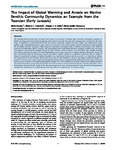The impact of global warming and anoxia on marine benthic community dynamics: an example from the Toarcian (Early Jurassic).
| dc.contributor.author | Danise, S | en |
| dc.contributor.author | Twitchett, RJ | en |
| dc.contributor.author | Little, CT | en |
| dc.contributor.author | Clémence, ME | en |
| dc.date.accessioned | 2015-05-01T14:08:57Z | |
| dc.date.available | 2015-05-01T14:08:57Z | |
| dc.date.issued | 2013-02-14 | en |
| dc.identifier.other | e56255 | en |
| dc.identifier.uri | http://hdl.handle.net/10026.1/3335 | |
| dc.description | PMCID: PMC3572952 | en |
| dc.description.abstract |
The Pliensbachian-Toarcian (Early Jurassic) fossil record is an archive of natural data of benthic community response to global warming and marine long-term hypoxia and anoxia. In the early Toarcian mean temperatures increased by the same order of magnitude as that predicted for the near future; laminated, organic-rich, black shales were deposited in many shallow water epicontinental basins; and a biotic crisis occurred in the marine realm, with the extinction of approximately 5% of families and 26% of genera. High-resolution quantitative abundance data of benthic invertebrates were collected from the Cleveland Basin (North Yorkshire, UK), and analysed with multivariate statistical methods to detect how the fauna responded to environmental changes during the early Toarcian. Twelve biofacies were identified. Their changes through time closely resemble the pattern of faunal degradation and recovery observed in modern habitats affected by anoxia. All four successional stages of community structure recorded in modern studies are recognised in the fossil data (i.e. Stage III: climax; II: transitional; I: pioneer; 0: highly disturbed). Two main faunal turnover events occurred: (i) at the onset of anoxia, with the extinction of most benthic species and the survival of a few adapted to thrive in low-oxygen conditions (Stages I to 0) and (ii) in the recovery, when newly evolved species colonized the re-oxygenated soft sediments and the path of recovery did not retrace of pattern of ecological degradation (Stages I to II). The ordination of samples coupled with sedimentological and palaeotemperature proxy data indicate that the onset of anoxia and the extinction horizon coincide with both a rise in temperature and sea level. Our study of how faunal associations co-vary with long and short term sea level and temperature changes has implications for predicting the long-term effects of "dead zones" in modern oceans. | en |
| dc.language | eng | en |
| dc.language.iso | eng | en |
| dc.title | The impact of global warming and anoxia on marine benthic community dynamics: an example from the Toarcian (Early Jurassic). | en |
| dc.type | Journal Article | |
| plymouth.author-url | http://www.ncbi.nlm.nih.gov/pubmed/23457537 | en |
| plymouth.issue | 2 | en |
| plymouth.volume | 8 | en |
| plymouth.journal | PLoS One | en |
| dc.identifier.doi | 10.1371/journal.pone.0056255 | en |
| plymouth.organisational-group | /Plymouth | |
| plymouth.organisational-group | /Plymouth/Research Groups | |
| plymouth.organisational-group | /Plymouth/Research Groups/Marine Institute | |
| dc.publisher.place | United States | en |
| dc.identifier.eissn | 1932-6203 | en |
| dc.rights.embargoperiod | Not known | en |
| rioxxterms.funder | Natural Environment Research Council | |
| rioxxterms.identifier.project | The evolution of modern marine ecosystems: environmental controls on their structure and function | |
| rioxxterms.versionofrecord | 10.1371/journal.pone.0056255 | en |
| rioxxterms.licenseref.uri | http://www.rioxx.net/licenses/all-rights-reserved | en |
| rioxxterms.type | Journal Article/Review | en |
| plymouth.funder | The evolution of modern marine ecosystems: environmental controls on their structure and function::Natural Environment Research Council | en |


